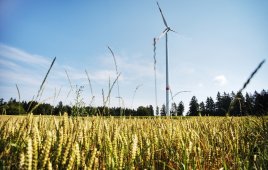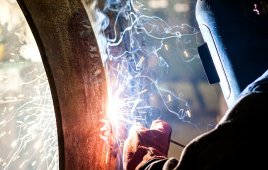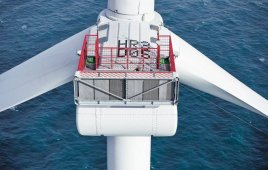
Mesa La Paz expects to issue in the short term new senior secured bonds for a total amount of $303 million with final maturity in December 2044 under a project-finance structure.
S&P Global Ratings’ Green Evaluation is a relative ranking of a financing’s green quality that lets S&P Global Ratings explicitly comment on a transaction’s alignment with the Green Bond Principles 2017. The evaluation of a transaction involves the assessment of transparency, governance and relative net environmental impact or Mitigation of a scale of 0 to 100.
It then combines these three elements to provide a final Green Evaluation score on a scale from 0 to 100 and R1 to R4. A higher number, or E1 or R1 score, indicates a higher relative net environmental impact or resilience benefit, respectively, over the funded assets’ life.
As a time-date assessment, a Green Evaluation is in part based on an estimate of the expected lifetime net environmental impact of a project should it perform to an industry average. A Green Evaluation is not a credit rating.
The following evaluation shows how it was applied to a new wind farm in Mexico:
Eolica Mesa La Pas S. de R.L. de C.V.’s Proposed $303 million bond
Transaction overview
Eolica Mesa La Paz (Mesa La Paz or the project) is a 306 megawatt (MW) onshore wind farm located in the state of Tamaulipas Mexico. The project is currently under construction and we expect the commencement of operations by September 2019. Mesa La Paz expects to issue in the short term new senior secured bonds for a total amount of $303 million with final maturity in December 2044 under a project-finance structure. All proceeds will partially fund the construction of the facility.
Project description
Mesa la Paz is a 306 MW greenfield onshore wind project located in the state of Tamaulipas Mexico that consists of 85 Vestas V136-3.6 MW turbines. The project also includes an operation and maintenance building, two substations, a project-own transmission line, and associated infrastructure.
Mesa la Paz expects to issue a new senior secured bond for $303 million with final maturity in December 2044 under a project-finance structure to partially fund the construction of the mentioned wind park. The bond will be labeled as green. The remaining funds for the construction of the project (estimated on an aggregate basis at about $430 million) will come from the project’s sponsors.
The project will benefit from a 25-year power purchase agreement (PPA) with Fuentes de Energia Penoles S.A. de C.V. that will be ultimately guaranteed by its parent, the metal producer Industrias Penoles S.A. de C.V. The PPA starts on April 1, 2020. Consequently, during the first seven years after commencement of operations, the PPA will cover only a portion (around 80%) of the energy generated, while the remained will be dispatched in the spot market.
Moreover, we believe this project fits properly within the government’s energy plans, considering Mexico’s intention to increase electricity generation from clean energy sources to 35% by 2024 and 50% by 2050 and to reduce greenhouse gas emissions by 30% by the end of a decade.
Scoring summary
This transaction achieved an overall Green Evaluation score of E1/91. E1 is the strongest Green Evaluation score on our scale of E1 (highest) to E4 (lowest). We have evaluated 100% of the proceeds of proposed $303 million bond allocated to the Mesa La Paz project. This score is determined by taking a weighted average of the excellent Transparency (80), solid Governance (95), and robust Mitigation (92) scores. In our view, renewable energy generation’s contribution toward system decarbonization, the strong governance framework, and transparent reporting mechanisms position this financing at the top end of our scale.
Rationale
- All proceeds from the debt issuance will be allocated to the construction of a wind farm, which ranks high in our carbon hierarchy, contributing to a strong mitigation score.
- Transparency and Governance scores are supported by a robust project finance legal structure that governs the use of cash as well as higher-level commitments to reporting on carbon-reduction efforts.
Key strengths and weaknesses
The key driver behind the E1 evaluation is the allocation of funds to a renewable windpower project. Renewable energy sits at the top of our carbon hierarchy, as we believe RE contributes to overall system decarbonization of the global economy. The environmental impact of wind projects typically ranks higher than solar on our scale given the better capacity factors over the life of wind projects. In the case of Mesa La Paz, the net benefit ranking of 70 reflects the high carbon intensity of Mexico’s grid, which relies primarily on thermal sources.
The excellent governance and above average transparency scores reflect the issuer’s decision to label the bond as green and to structure the transaction as project finance, which contemplates the creation of a cash flow waterfall and specific accounts to isolate the proceeds. In addition, the independent engineer will track, on a quarterly basis during the construction and annual basis during operations, environmental and social objectives such as visual impact, noise, biodiversity, shadow flicker, water quality, and workplace and community safety and hygiene.
Mesa La Paz does not intend to report the avoided carbon emissions during the operational phase of the project however it does intend to report on other environmental indicators including noise, biodiversity, shadow flicker and water quality during the full life cycle of the asset.
Filed Under: Financing




